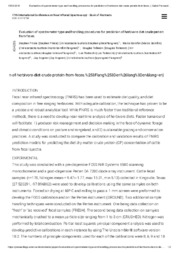Evaluation of spectrometer type and handling procedures for prediction of herbivore diet crude protein from feces.
Evaluation of spectrometer type and handling procedures for prediction of herbivore diet crude protein from feces.
Author(s): PRINCE, S.; BOMFIM, M. A. D.; TOLLESON, D.; TEDESCHI, L.; ANGERER, J.
Summary: Fecal near infrared spectroscopy (FNIRS) has been used to estimate diet quality, and diet composition in free ranging herbivores. With adequate calibration, the technique has proven to be a precise and robust analytical tool. While FNIRS is much faster than traditional reference methods, there is a need to develop near real-time analysis of herbivore diets. Faster turnaround will facilitate: 1) producer risk management and decision making in the face of dynamic forage and climatic conditions on pasture and rangeland, and 2) sustainable grazing and conservation practices. A study was conducted to compare the calibration and validation results of FNIRS prediction models for predicting the diet dry matter crude protein (CP) concentration of cattle from fecal spectra. This study provides proof of concept for using alternate sample handling techniques in an effort to more quickly disseminate nutritional information to grazing animal managers.
Publication year: 2015
Types of publication: Abstract in annals or event proceedings
Unit: Embrapa Goats & Sheep
Observation
Some of Embrapa's publications are published as ePub files. To read them, use or download one of the following free software options to your computer or mobile device. Android: Google Play Books; IOS: iBooks; Windows and Linux: Calibre.
Access other publications
Access the Agricultural Research Database (BDPA) to consult Embrapa's full library collection and records.
Visit Embrapa Bookstore to purchase books and other publications sold by Embrapa.

